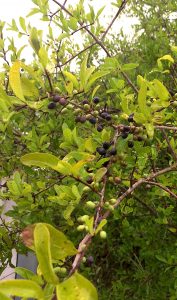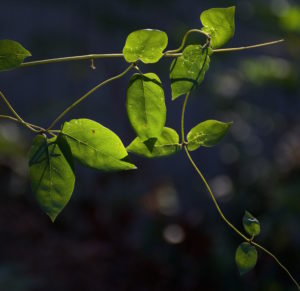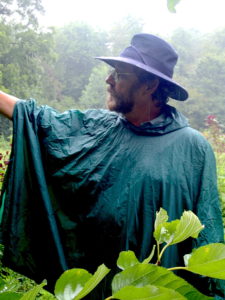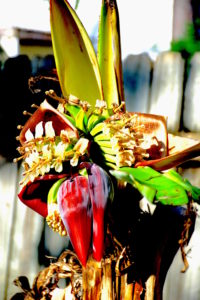
WHAT DO YOU SEE #25: There are at least three edible species in this picture, some writers would list four. Can you identify them? Photo by Green Deane
It may be December but locally there is still plenty to forage. Beautyberries are still producing. I had a student tell me recently she made Beautyberry Bread. Now that’s innovative! One can still find Simpson Stopper berries here and there. One of the more odd edibles still in fruit are Wild Pineapples. I’m not sure how “wild” they are but they are in the pineapple family and were planted long ago as ornamentals. Many jurisdictions don’t even acknowledge the species grows here. What is odd about the apricot-sized fruit is edibility. Some people seem to be able to eat them and others not. I think like other members of the pineapple family they may have enzymes at affect proteins. When I eat a ripe fruit my tongue gets “scruffy” and my taste buds don’t work well for a while. Other people have no problem with them. You can read more about them here.
New foragers often complain they don’t know where to look for edible weeds. Foraging is much like dating: Knowing where to look is important. Fundamentally we look for disturbed ground (such as land clearing, holes, piles of dirt) wet spots including low lawns and ditches, and transition zones. Those are areas between grass and shrubs, shrubs and forest, paths and forests, reparian places such as shore lines. Another place to look is neglected area and or places that have not been tended to, as one sees in the photograph to the right. While this roadside is not a good place to forage the point is the signs prevented mowing and Amaranth not only sprouted but had enough time to grow to maturity and seed.
Foraging Classes: Except for hurricanes foraging classes usually are held as scheduled. We’re hungry when we are cold and wet so foraging classes are held when it is wet and when it is cold, as it might be this weekend. Sometimes during the holiday season classes are moved around some.
Saturday, December 10th, Colby-Alderman Park: 1099 Massachusetts Street, Cassadaga. Fla. 32706. 9 a.m.
Sunday, December 11th, Blanchard Park, 10501 Jay Blanchard Trail, Orlando, FL 32817. 9 a.m. We meet near the tennis court.
Sunday, December 18th, Dreher Park, 1200 Southern Blvd., West Palm Beach, 33405. 9 a.m.
To learn more about the classes, go here.

Forestiera segregata, Florida Privet, not edible.
The following is sheer speculation. While teaching a class in the coastal area south of Daytona Beach we saw a salt-tolerant shrub with blue berries. This is not the first time I’ve seen the plant and mentioned it in a newsletter last year. The species is Forestiera segregata, or Florida Privet aka Swamp Privet. I suspect it has never worked its way into ethnobotanical literate because the berries taste bad. I’m not sure, however, if the story ends there. The straight limbs were used for arrow and the berries possibly used for ink. The berries are considered not edible. That said I have not found any references to toxicity but that might be because they are too foul to eat. However, it is in the Olive family and olives don’t taste good unless “cured.” What I wonder is 1) if the fruit are edible if 2) they are treated like olives? It’s pure speculation on my part. They could be toxic for all I know. But it’s an idea.
It may be winter but the Bananas don’t know that, yet. They are two-year herbs fruiting their second year. If the winter in between the two seasons is too cold there won’t be any Bananas. In fact, I had Bananas and Olives in my yard. If it was cold enough for Olives there would be no Bananas that following year. Or if the Bananas survived it was not cold enough for Olives. There is also more to eat on a Banana “tree” than just the banana. It’s even medicinal and the leaves can be used for cooking. Incidentally commercial bananas might disappear from the stores. Indeed, the common banana now is not the commercial banana we ate when I was a kid. To read more about the Banana, go here.
What Do You See #25? Usually the answer is printed next week but as this newsletter skipped a week and two of these plant are coming into season we’ll cover the answer now. Easy to spot in the lower middle is an Oxalis, perhaps O. acuta. We have two large groups of Oxalis locally and this one is from the Caribbean Islands. They are tart. I call them ‘rhubarb lite.’ In the upper left corner with the scalloped leaves is a wild geranium, either a Cranes Bill or a Stork’s bill. They are extremely bitter and are used more medicinally but some writers include them in the realm of edible. In the lower left of the photograph is Pellitory, or Cucumber Weed. It is well into its seasonal run and will be around for a few months. It likes to grow in shade and does taste like cucumber (smells like it, too.) The majority of the plants in the photograph, however, are Goosegrass also called Cleavers. They are the ones with whorls. Edible when young they also have a short seasons, another reason to mention them here. While edible they are reportedly good for the lymph system.
All of Green Deane’s videos are available for free on You Tube. They do have ads on them so every time you watch a Green Deane video I get a quarter of one cent. Four views, one cent. Not exactly a large money-maker but it helps pays for the newsletter. If you want to see the videos without ads and some in slightly better quality you can order the DVD set. It is nine DVDs with 15 videos on each. They make a good Christmas gift. Many people want their own copy of the videos or they have a slow service and its easier to order then to watch them on-line. They make a good gift for that forager you know. Individual DVDs can also be ordered. You can order them by clicking on the button on the top right of this page or you can go here. If that link is not working — there have been some issues — you can use a donation link and email me your order and address.

Do you know this edible? You would if you read the Green Deane Forum.
Want to identify a plant? Looking for a foraging reference? Do you have a UFO, an Unidentified Flowering Object you want identified? On the Green Deane Forum we chat about foraging all year. And it’s not just about warm-weather plants or just North American flora. Many nations around the world share common weeds so there’s a lot to talk about. There’s also more than weeds. The reference section has information for foraging around the world. There are also articles on food preservation, and forgotten skills from making bows to fermenting food. You can join the forum by clicking on the button on the upper right hand side of this page.
This is Newsletter 235.
If you would like to donate to Eat The Weeds please click here.







Oh…. I answered picture before I finished reading….
Dean have you considered publishing, or branching out to other states with your classes. I live in Nash TN and have looked for some class I can attend without any luck. I am sure it would grow across many states with someone like you as a overseer.
“To New Foragers is of interest to me as I hope to include this important guide to my Arabic readers in my book on which I’m at present putting much effort. With respect to this I may add that, after retuing home ( one month visit to Irdland) I came to find in a spot of my back garden – thus considered – a well grown ” Morning Glory ( Ipomea sinensis) with flowers and fruits. As I can remember, I’ve planted some seeds I brought from UK. That was on March2015; but getting nothing I forgot about that plant. Instead a grape was transplanted in the same place. Again I gave up because it withdred spite of enough water and fertilizer.
I love trying to remember all the plant’s you show us. But after a while all I see is green and it makes my brain hurt. Is there a trick to training ones mind to hold and remember what it see’s ? Florida has so much to learn in it’s plants. For food and medican. Thanks for your help. Caveman 🙂
Take it one plant at a time as they are in season.